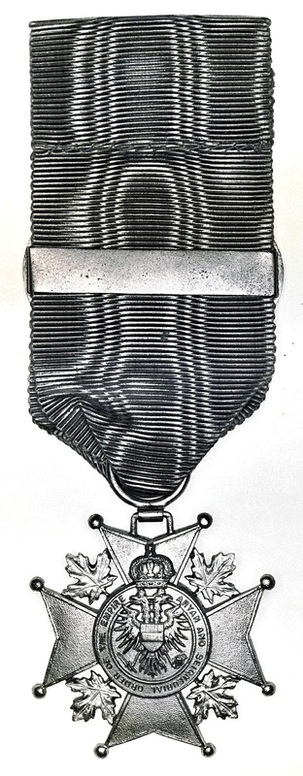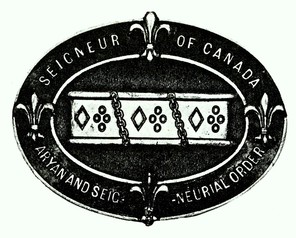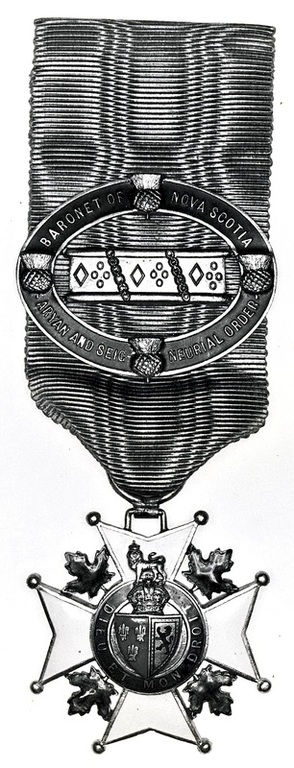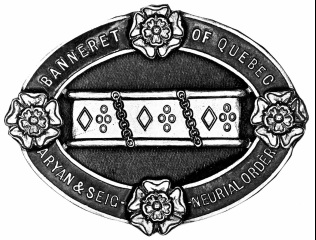F
FAUTEUX, Aegidius (1876–1941)
Journaliste, bibliothécaire, essayiste et historien né à Montréal. Il est l’auteur de Les Chevaliers de Saint-Louis en Canada, Montréal, Les Éditions des Dix, 1940 et d’un Armorial du Canada français dont le manuscrit inédit, est conservé à la Bibliothèque municipale de Montréal.
***
Quebec journalist, librarian, essayist and historian, Aegidius Fauteux was born in Montreal. He is the author of Les Chevaliers de Saint-Louis en Canada (Montreal: Les Éditions des Dix, 1940) and of Armorial du Canada français, kept in manuscript form at the Municipal Library of Montreal.
FORNEL (Fournel), Louis (Jean-Louis) (1698-1745)
Marchand, entrepreneur, explorateur et seigneur, le 11 juillet 1743 il prenait possession de la baie des Esquimaux (probablement Hamilton Inlet, Labrador) en arborant le pavillon blanc de la marine royale.*
« Etant resté tout le jour mouillé à cause des vents contraires nous serions descendus à terre; et sur une éminence nous aurions planté deux grandes croix aux pieds desquelles étant à genoux nous aurions chanté plusieurs cantiques et hymnes en action de grâce de notre heureuse arrivée et au mesme lieu nous aurions arboré le pavillon français en criant à diverses reprises Vive le Roy pour marquer de la prise de possession que nous faisions au nom du Roy, et de la nation française d'une terre qui n'auroit encore jamais été habitée par aucune nation, et dont nous sommes les premiers qui en prenons possession*. »
Pour les Canadiens de l’époque le pavillon blanc était vu comme étant celui de la nation française,*, ce que vient confirmer le fait que Fornel, Canadien de naissance, hissait ce drapeau au nom du roi et de la nation française. Traditionnellement, on arborait les armes royales, trois fleurs de lis dorées sur champ bleu, et non un drapeau pour symboliser la souveraineté du roi de France lors des prises de possession de nouveaux territoires. On les fixait à des croix, des poteaux, des arbres ou on les enterrait gravées sur métal. Voir CARTIER, CAVELIER DE LA SALLE, DAUMONT DE SAINT-LUSSON et GAULTIER DE LA VÉRENDRYE.
Réf : * Auguste Vachon, « Bannière de France et pavillon blanc en Nouvelle-France » dans HC, année 2008, p. 19-33.
**« Relation de la découverte qu'a faite le sieur louis fornel en 1743 de la baie des eskimaux nommée par les sauvages kessessakiou » dans Rapport de l'Archiviste de la province de Québec pour 1920-1921, Québec, Ls-A. Proulx, 1921, p. 69-70. Pavillon français est synonyme de pavillon blanc. Il existait un pavillon royal, blanc semé de fleurs de lis d’or avec les grandes armoiries royales, couronne, colliers et supports, qu’on utilisait parfois sur des navires de guerre, mais à partir de 1702, il était réservé à des navires ayant le roi à bord. Hervé Pinoteau, La symbolique royale française Ve-XVIIIe siècles, Loudun, PSR Éditions, 2003, p. 660.
***
Louis Fornel was a merchant, entrepreneur, explorer, and seigneur. On July 11, 1743 he raised the white flag of the French Royal Navy at Baie des Esquimaux (probably Hamilton Inlet, Labrador) to claim the surrounding lands in the name of the king and French nation. At that time the white flag was viewed as national flag of France by Canadians. The fact that Fornel was Canadian born is further proof of the national status that Canadians conferred upon this flag. Flags were rarely raised to take possession of new lands in the name of the French king. At such ceremonies, the sovereignty of the king was almost always symbolized by the royal arms, three gold fleurs-de-lis on a blue field. They were affixed to crosses, posts or trees, and sometimes were engraved in metal and buried in the ground. See CARTIER, CAVELIER DE LA SALLE, DAUMONT DE SAINT-LUSSON and GAULTIER DE LA VÉRENDRYE.
FOULIS, Robert (1796-1866)
Born in Glasgow, Scotland; came to Halifax, N.S., in 1819. Is best known as an engineer and inventor. He earned a living in Halifax as a portrait painter and as an art teacher. In 1822, he moved to Saint John N.B. where he worked as a civil engineer. “Painted sporadically during entire N.B. career; chiefly a portraitist but also executed heraldic work and did engraving.”*
Ref: *Harper, Early Painters and Engravers (p. 117; Dictionary of Canadian Biography online Bibliog.).
FOURNIER, Paul-André (env. 1915- 1999).
L’un des directeurs de la SHC, il a œuvré pour l’établissement de l’AHC, a été reçu sociétaire honoraire (Honorary Fellow) de la SHC en 1987 et obtint une concession d’armoiries de l’AHC, le 18 juin 1989. Connu comme collectionneur d’ex-libris, en grande partie armoriés, il fit don de son imposante collection à l’Université Laval et prépara sur le sujet une thèse de doctorat dirigée par Jean Simard : L’ex-libris et les formes changeantes de l’expression identitaire dans les arts graphiques du XVe siècle à nos Jours, 1996. Lors de la remise de son grade en 1997, il était âgé de 82 ans. Le capitaine Fournier, C.D., était aussi membre de la Société de généalogie de Québec et de la Société Alcuin. Il fut l’auteur de plusieurs articles sur l’ex-libris et l’héraldique : Ex-libris canadiens, Québec [1972] qui marquait la présence du Québec au 14e congrès international d’ex-libris à Elseneur (Helsingör), Danemark, 1972; « Généalogie d’un néo-Québécois : Éric de Warren » dans HC, Mars 1987, p. 15-22; « L’héraldisme au Canada » dans Cap-aux-Diamants, vol. 5, no 4, hiver 1990, p. 57-59.
***
As one of the directors of the HSC, Paul-André Fournier promoted the establishment of the CHA; was made an Honorary Fellow of the HSC in 1987 and obtained a grant of arms from the CHA on 18 June 1989. The huge collection of bookplates he assembled, many of which were armorial, was given to Laval University and became the basis of his PhD thesis directed by Jean Simard: L’ex-libris et les formes changeantes de l’expression identitaire dans les arts graphiques du XVe siècle à nos Jours, 1996. He was 82 when he received his doctorate. Captain Fournier CD was also a member of the Société de généalogie de Québec and the Alcuin Society. He is the author of many articles on bookplates and heraldry: Ex-libris Candiens, Quebec [1972], which highlighted Quebec participation in the 14th International Bookplate Congress at Elsinore, (Helsingör), Denmark, 1972; “Généalogie d’un néo-Québécois : Éric de Warren” in HC, March 1987, p. 15-22; “L’héraldisme au Canada” in Cap-aux-Diamants, vol. 5, no. 4 (Winter 1990), p. 57-59.
FRENIÈRE, F. Daunais (Connu au Canada 1833-43)
Peintre décorateur en Angleterre et aux États-Unis, puis à Montréal à partir de 1833. Il peignait des armoiries, des diapositives sur verre, des cartes et des enseignes.
Réf: Harper, Early Painters and Engravers (Bibliog.), p. 121; David Karel, dir., Dictionnaire des artistes de langue française en Amérique du Nord, Québec, Musée du Québec et Les Presses de l'Université Laval, 1992, p. 317.
***
F. Daunais Frenière was a decorative painter in London, Eng. and U.S. before settling in Montreal in 1833. He painted coats of arms, transparencies on glass, maps and signs.”
FRONSAC, Frédéric Gregory Forsyth, Vicomte de (1856-1925)
Born in Montreal. Was one of the strangest figures in Canadian genealogy and heraldry who attempted to trace his own title of vicomte to the times of Charlemagne. A great disappointment in his life was his failure to be accepted at West Point and to pursue a military career as his father had done. He believed in the monarchy, which had its roots in the pure blooded Aryan warriors of Gothic Europe who formed the Nobility of State and chose among them a leader to become their monarch. He saw William of Orange as a usurper to the throne who had promoted parliamentary democracy, a regime without a code of honour, which ended in corruption because of party interests, the same regime that was implanted in Canada and the United States. He would have liked Canada to be an independent country with its own sovereign. On the other hand, he favoured freedom of religion, multiculturalism, and the protection of the less fortunate. His life work was dedicated to uniting and promoting the rights of all noble elements in North America such as the Baronets of Nova Scotia and the nobility of New France whose rights, according to him, were recognized by the Treaty of Paris of 1763 and the Quebec Act of 1774. He endeavoured to document the genealogies and armorial bearings of any North American family he considered to have noble affiliation. He admired the Loyalists and claims to have chaired the founding meeting of the United Empire Loyalists Association in Montreal in 1895. He assumed the title of: “Herald-Marshal of the United Empire Loyalists, Chapter of the Argyll Order of St. George.” In the early 1900, his letterhead read: “L’Ordre Aryen Royal et Seigneurial de la Noblesse du Canada et de l’Acadie.” In the spring of 1904, he established his “Collège des Armes de l’Ordre Aryen de l’Empire en Canada,” which he later called “College of Arms of Canada” and “College of Arms of the Noblesse in Canada.” He created his own honour system, the “Aryan and Seigneurial Order of the Empire” with a specific colour of ribbon and a distinctive clasp to identify each class he considered as belonging to this select group, such as Seigneurs of Canada, Baronets of Nova Scotia, Bannerets of Quebec, Virginia Order of the Knights of the Golden Horseshoe of Tramontane, Equestors of the Order of the Yellow Rose of the Empire in America. All these institutions and titles were his own creations for which he had no official authority. Some of the names he recorded were of noble descent, but other cases were dubious. He was considered a charlatan and an unrelenting pest by such government officials as Sir Joseph POPE and Sir Arthur DOUGHTY. After his death, the papers of his College of Arms, for which he sought a home for many years, were put in the care of Alain Joly de Lotbinière.
Ref: Auguste Vachon, “Frédéric Gregory Forsyth, Vicomte de Fronsac: a Man in Search of a Kingdom” in HC, Sept. 1990, p. 18-27.
Journaliste, bibliothécaire, essayiste et historien né à Montréal. Il est l’auteur de Les Chevaliers de Saint-Louis en Canada, Montréal, Les Éditions des Dix, 1940 et d’un Armorial du Canada français dont le manuscrit inédit, est conservé à la Bibliothèque municipale de Montréal.
***
Quebec journalist, librarian, essayist and historian, Aegidius Fauteux was born in Montreal. He is the author of Les Chevaliers de Saint-Louis en Canada (Montreal: Les Éditions des Dix, 1940) and of Armorial du Canada français, kept in manuscript form at the Municipal Library of Montreal.
FORNEL (Fournel), Louis (Jean-Louis) (1698-1745)
Marchand, entrepreneur, explorateur et seigneur, le 11 juillet 1743 il prenait possession de la baie des Esquimaux (probablement Hamilton Inlet, Labrador) en arborant le pavillon blanc de la marine royale.*
« Etant resté tout le jour mouillé à cause des vents contraires nous serions descendus à terre; et sur une éminence nous aurions planté deux grandes croix aux pieds desquelles étant à genoux nous aurions chanté plusieurs cantiques et hymnes en action de grâce de notre heureuse arrivée et au mesme lieu nous aurions arboré le pavillon français en criant à diverses reprises Vive le Roy pour marquer de la prise de possession que nous faisions au nom du Roy, et de la nation française d'une terre qui n'auroit encore jamais été habitée par aucune nation, et dont nous sommes les premiers qui en prenons possession*. »
Pour les Canadiens de l’époque le pavillon blanc était vu comme étant celui de la nation française,*, ce que vient confirmer le fait que Fornel, Canadien de naissance, hissait ce drapeau au nom du roi et de la nation française. Traditionnellement, on arborait les armes royales, trois fleurs de lis dorées sur champ bleu, et non un drapeau pour symboliser la souveraineté du roi de France lors des prises de possession de nouveaux territoires. On les fixait à des croix, des poteaux, des arbres ou on les enterrait gravées sur métal. Voir CARTIER, CAVELIER DE LA SALLE, DAUMONT DE SAINT-LUSSON et GAULTIER DE LA VÉRENDRYE.
Réf : * Auguste Vachon, « Bannière de France et pavillon blanc en Nouvelle-France » dans HC, année 2008, p. 19-33.
**« Relation de la découverte qu'a faite le sieur louis fornel en 1743 de la baie des eskimaux nommée par les sauvages kessessakiou » dans Rapport de l'Archiviste de la province de Québec pour 1920-1921, Québec, Ls-A. Proulx, 1921, p. 69-70. Pavillon français est synonyme de pavillon blanc. Il existait un pavillon royal, blanc semé de fleurs de lis d’or avec les grandes armoiries royales, couronne, colliers et supports, qu’on utilisait parfois sur des navires de guerre, mais à partir de 1702, il était réservé à des navires ayant le roi à bord. Hervé Pinoteau, La symbolique royale française Ve-XVIIIe siècles, Loudun, PSR Éditions, 2003, p. 660.
***
Louis Fornel was a merchant, entrepreneur, explorer, and seigneur. On July 11, 1743 he raised the white flag of the French Royal Navy at Baie des Esquimaux (probably Hamilton Inlet, Labrador) to claim the surrounding lands in the name of the king and French nation. At that time the white flag was viewed as national flag of France by Canadians. The fact that Fornel was Canadian born is further proof of the national status that Canadians conferred upon this flag. Flags were rarely raised to take possession of new lands in the name of the French king. At such ceremonies, the sovereignty of the king was almost always symbolized by the royal arms, three gold fleurs-de-lis on a blue field. They were affixed to crosses, posts or trees, and sometimes were engraved in metal and buried in the ground. See CARTIER, CAVELIER DE LA SALLE, DAUMONT DE SAINT-LUSSON and GAULTIER DE LA VÉRENDRYE.
FOULIS, Robert (1796-1866)
Born in Glasgow, Scotland; came to Halifax, N.S., in 1819. Is best known as an engineer and inventor. He earned a living in Halifax as a portrait painter and as an art teacher. In 1822, he moved to Saint John N.B. where he worked as a civil engineer. “Painted sporadically during entire N.B. career; chiefly a portraitist but also executed heraldic work and did engraving.”*
Ref: *Harper, Early Painters and Engravers (p. 117; Dictionary of Canadian Biography online Bibliog.).
FOURNIER, Paul-André (env. 1915- 1999).
L’un des directeurs de la SHC, il a œuvré pour l’établissement de l’AHC, a été reçu sociétaire honoraire (Honorary Fellow) de la SHC en 1987 et obtint une concession d’armoiries de l’AHC, le 18 juin 1989. Connu comme collectionneur d’ex-libris, en grande partie armoriés, il fit don de son imposante collection à l’Université Laval et prépara sur le sujet une thèse de doctorat dirigée par Jean Simard : L’ex-libris et les formes changeantes de l’expression identitaire dans les arts graphiques du XVe siècle à nos Jours, 1996. Lors de la remise de son grade en 1997, il était âgé de 82 ans. Le capitaine Fournier, C.D., était aussi membre de la Société de généalogie de Québec et de la Société Alcuin. Il fut l’auteur de plusieurs articles sur l’ex-libris et l’héraldique : Ex-libris canadiens, Québec [1972] qui marquait la présence du Québec au 14e congrès international d’ex-libris à Elseneur (Helsingör), Danemark, 1972; « Généalogie d’un néo-Québécois : Éric de Warren » dans HC, Mars 1987, p. 15-22; « L’héraldisme au Canada » dans Cap-aux-Diamants, vol. 5, no 4, hiver 1990, p. 57-59.
***
As one of the directors of the HSC, Paul-André Fournier promoted the establishment of the CHA; was made an Honorary Fellow of the HSC in 1987 and obtained a grant of arms from the CHA on 18 June 1989. The huge collection of bookplates he assembled, many of which were armorial, was given to Laval University and became the basis of his PhD thesis directed by Jean Simard: L’ex-libris et les formes changeantes de l’expression identitaire dans les arts graphiques du XVe siècle à nos Jours, 1996. He was 82 when he received his doctorate. Captain Fournier CD was also a member of the Société de généalogie de Québec and the Alcuin Society. He is the author of many articles on bookplates and heraldry: Ex-libris Candiens, Quebec [1972], which highlighted Quebec participation in the 14th International Bookplate Congress at Elsinore, (Helsingör), Denmark, 1972; “Généalogie d’un néo-Québécois : Éric de Warren” in HC, March 1987, p. 15-22; “L’héraldisme au Canada” in Cap-aux-Diamants, vol. 5, no. 4 (Winter 1990), p. 57-59.
FRENIÈRE, F. Daunais (Connu au Canada 1833-43)
Peintre décorateur en Angleterre et aux États-Unis, puis à Montréal à partir de 1833. Il peignait des armoiries, des diapositives sur verre, des cartes et des enseignes.
Réf: Harper, Early Painters and Engravers (Bibliog.), p. 121; David Karel, dir., Dictionnaire des artistes de langue française en Amérique du Nord, Québec, Musée du Québec et Les Presses de l'Université Laval, 1992, p. 317.
***
F. Daunais Frenière was a decorative painter in London, Eng. and U.S. before settling in Montreal in 1833. He painted coats of arms, transparencies on glass, maps and signs.”
FRONSAC, Frédéric Gregory Forsyth, Vicomte de (1856-1925)
Born in Montreal. Was one of the strangest figures in Canadian genealogy and heraldry who attempted to trace his own title of vicomte to the times of Charlemagne. A great disappointment in his life was his failure to be accepted at West Point and to pursue a military career as his father had done. He believed in the monarchy, which had its roots in the pure blooded Aryan warriors of Gothic Europe who formed the Nobility of State and chose among them a leader to become their monarch. He saw William of Orange as a usurper to the throne who had promoted parliamentary democracy, a regime without a code of honour, which ended in corruption because of party interests, the same regime that was implanted in Canada and the United States. He would have liked Canada to be an independent country with its own sovereign. On the other hand, he favoured freedom of religion, multiculturalism, and the protection of the less fortunate. His life work was dedicated to uniting and promoting the rights of all noble elements in North America such as the Baronets of Nova Scotia and the nobility of New France whose rights, according to him, were recognized by the Treaty of Paris of 1763 and the Quebec Act of 1774. He endeavoured to document the genealogies and armorial bearings of any North American family he considered to have noble affiliation. He admired the Loyalists and claims to have chaired the founding meeting of the United Empire Loyalists Association in Montreal in 1895. He assumed the title of: “Herald-Marshal of the United Empire Loyalists, Chapter of the Argyll Order of St. George.” In the early 1900, his letterhead read: “L’Ordre Aryen Royal et Seigneurial de la Noblesse du Canada et de l’Acadie.” In the spring of 1904, he established his “Collège des Armes de l’Ordre Aryen de l’Empire en Canada,” which he later called “College of Arms of Canada” and “College of Arms of the Noblesse in Canada.” He created his own honour system, the “Aryan and Seigneurial Order of the Empire” with a specific colour of ribbon and a distinctive clasp to identify each class he considered as belonging to this select group, such as Seigneurs of Canada, Baronets of Nova Scotia, Bannerets of Quebec, Virginia Order of the Knights of the Golden Horseshoe of Tramontane, Equestors of the Order of the Yellow Rose of the Empire in America. All these institutions and titles were his own creations for which he had no official authority. Some of the names he recorded were of noble descent, but other cases were dubious. He was considered a charlatan and an unrelenting pest by such government officials as Sir Joseph POPE and Sir Arthur DOUGHTY. After his death, the papers of his College of Arms, for which he sought a home for many years, were put in the care of Alain Joly de Lotbinière.
Ref: Auguste Vachon, “Frédéric Gregory Forsyth, Vicomte de Fronsac: a Man in Search of a Kingdom” in HC, Sept. 1990, p. 18-27.



